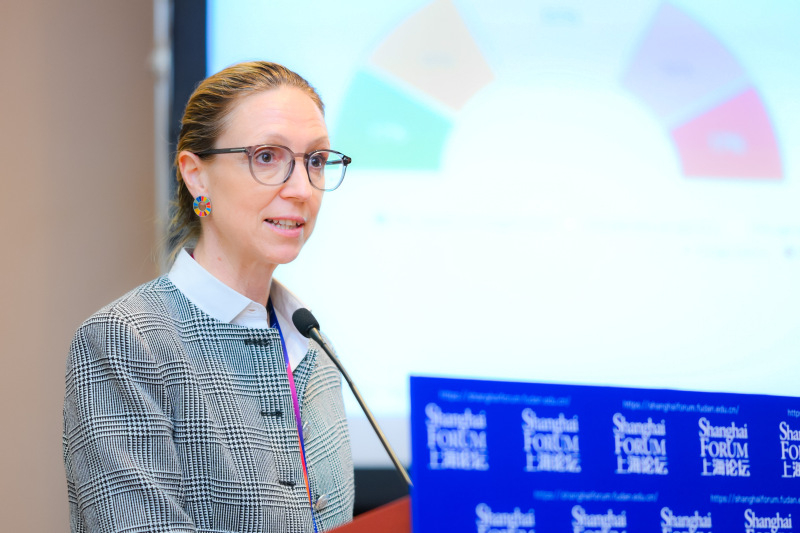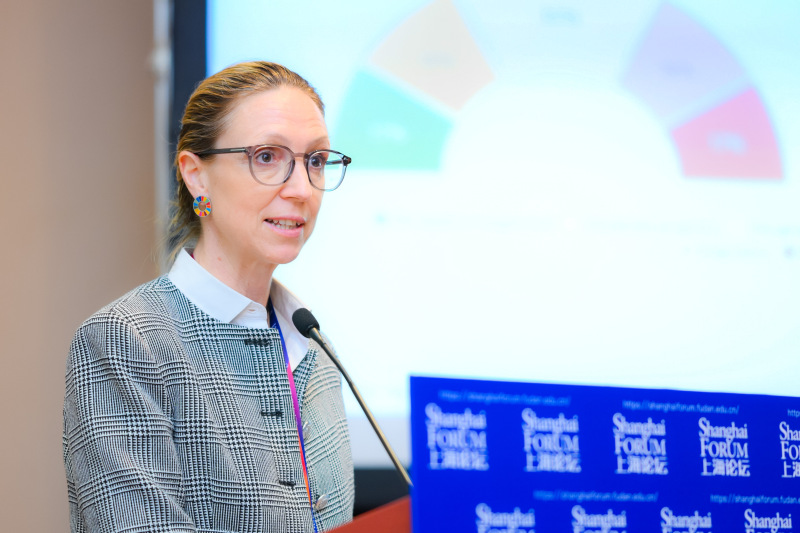“A successful green transition must be inclusive and just—not only technologically sound, but also socially sensitive,” said Violante di Canossa, Chief Economist and Head of the Strategic Partnerships and Policy Team at UNDP China, during the 2025 Shanghai Forum.

In a conversation centered on the future of international green finance, di Canossa shared her insights on how inclusive policymaking can drive sustainable development. Drawing from her experience in development policy, she emphasized China’s unique role in leading a socially responsive climate transition—one that integrates decarbonization efforts with social justice and gender equity.
Q: From UNDP’s perspective, how would you assess China’s progress in achieving the Sustainable Development Goals (SDGs)? What steps are needed to accelerate progress?
di Canossa: China has made significant progress in promoting environmental sustainability. According to the 2025 International Renewable Energy Agency (IRENA), the country now accounts for 47% of global installed capacity in solar and wind energy.
However, as the world’s largest emitter—responsible for about 30% of global emissions—China still faces significant challenges. Its Dual Carbon Goals, which aim to peak carbon emissions before 2030 and reach carbon neutrality before 2060, have played a vital role in accelerating climate action both domestically and internationally.
To achieve these goals, China must set ambitious and actionablegoals while adopting a whole-of-economy approach. This includes prioritizing the decarbonization of high emission manufacturing sectors. The expansion of the National Emissions Trading System beyond the power industry to cover a broader range of polluters is an important step in that direction.
Equall important is ensuring that the transition is not only low carbon but also inclusive and equitable. This remains a key priority in UNDP’s collaboration with China. Together, we have launched a wide range of initiatives—from supporting policy development and testing new low-carbon technologies to exploring innovative ways to drive climate finance.
Q: Beyond reducing emissions, you highlighted the importance of making the green transition socially “inclusive and equitable”. Why is this social dimension so crucial, and how is UNDP addressing it in practice?
di Canossa: One of the core principles of the 2030 Agenda for Sustainable Development is “leaving no one behind,” which guides all of UNDP’s work. It calls for placing human development at the center of all policies and strategies, extending beyond purely economic growth. This idea has led to the creation of the Human Development Index (HDI), a broader assessment of a country’s progress that takes people and their capabilities as ultimate criteria, especially in health, education, and standard of living.
Applying this to the green transition means looking closely at its socio-economic impacts. We have focused on two key sectors: coal mining and electricity. In 2023 and 2024, we published two in-depth reports analyzing how the shift to low-carbon development affects different regions, especially coal-producing provinces. The findings show that impacts vary widely depending on local employment structures, industrial capacity, and growth potential.
To make the transition both sustainable and fair, it is essential to adopt policies that not only reduce emissions but also protect those most vulnerable to the changes. Our research paid particular attention to informal workers and women—groups often overlooked in climate policy—and we provided a set of evidence-based policy recommendations to support them through the shift.
Q: Could you share some key findings from your study on these vulnerable workers affected by China’s energy transition?
di Canossa: Our study focuses on Shanxi Province, one of China’s most coal-dependent regions. The study examined how the shift to a low-carbon economy affects workers and what policies should be taken to ensure equity and inclusivity of the transition.
We identified several challenges. Many coal workers, having lived through the industry’s past boom-and-bust cycles, may not yet recognize that the move toward carbon neutrality marks an irreversible shift. Despite the physically demanding and harsh working conditions of the coal industry, its relatively high short-term wages make many workers reluctant to move to other emerging industries. Besides, education and skill levels are also a barrier. Many workers lack the qualifications or training needed to take on new roles in the green economy.
Using data-driven analysis, we aim to support policies that better address these realities. For instance, tailored training programs for emerging low-carbon sectors can support a smoother transition and help prevent growing inequality. Gender considerations are also critical, as women are often disproportionately affected by the coal sector’s decline.
Q: As you mentioned the importance of gender perspective, what role does gender equality play in sustainable development, and how is UNDP working to empower women in China and across the region?
di Canossa: For any economy to grow sustainably, it must make full use of all its productive forces, including the significant contribution of women in the labor force. However, realizing this potential requires more determined action worldwide.
According to the World Bank, women make up 40.2% of the global workforce in 2024. China performs slightly better, with women accounting for 45.1% of its workforce. The country ranks 41st globally on the Gender Inequality Index (GII), which measures gender disparities in reproductive health, empowerment, and labor market participation. This reflects meaningful progress on Sustainable Development Goal 5 of gender equality. However, challenges also remain particularly in unequal opportunities and income gaps in rural and underdeveloped areas.
To support women’s contributions to sustainable development, UNDP works across China to strengthen their roles in areas such as leadership, rural entrepreneurship, renewable energy, and the fast-growing tech industry.
At the policy level, UNDP China, in collaboration with the Gender Team at UNDP’s Bangkok Regional Hub, launched a study exploring the status of women in STEM (Science, Technology, Engineering, and Math) across the Asia-Pacific region. The report provides practical, targeted recommendations to boost women and girls’ participation in STEM, targeting a wide range of stakeholders—from policymakers and educators to the private sector and media, as well as UNDP itself.
(END)
Writer: HU Chenxin
Proofreader: WANG Jingyang
Editor: WANG Mengqi, LI Yijie




